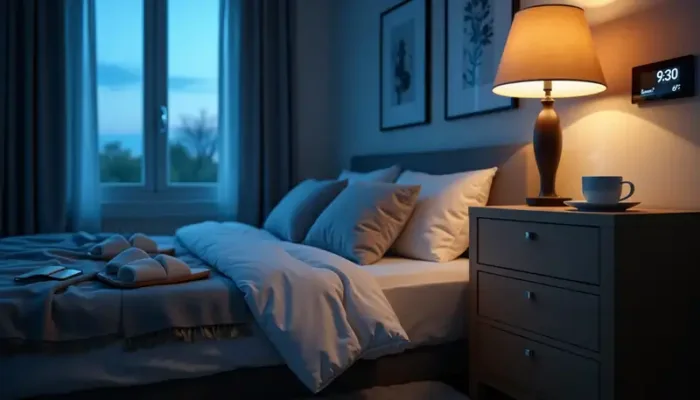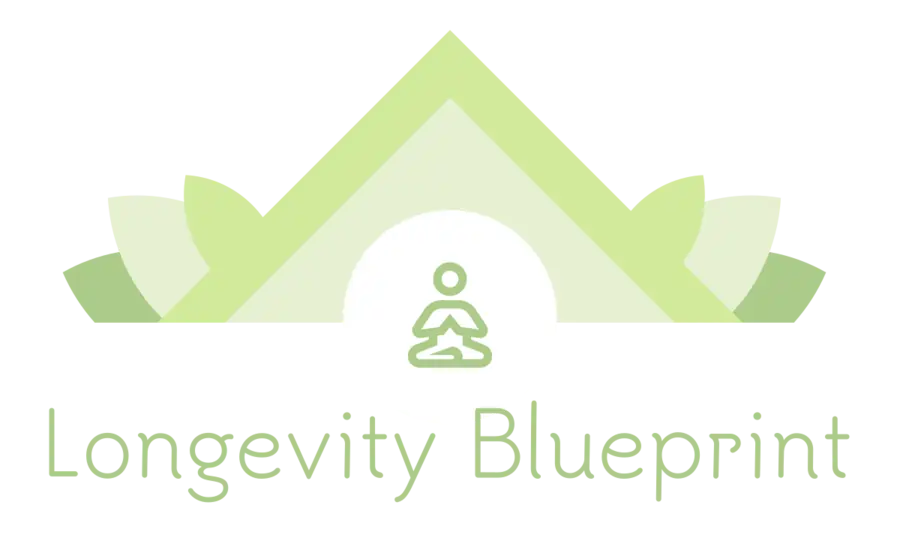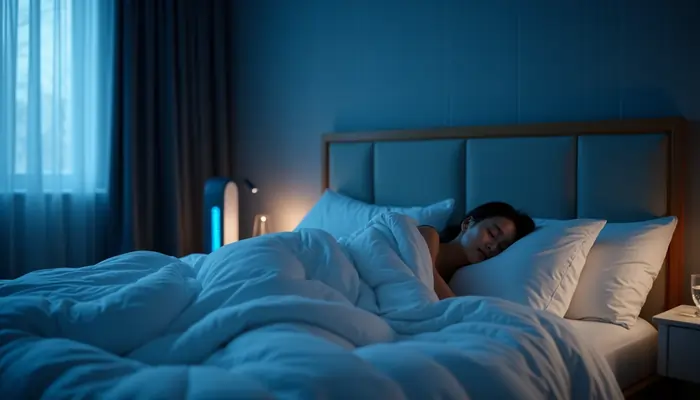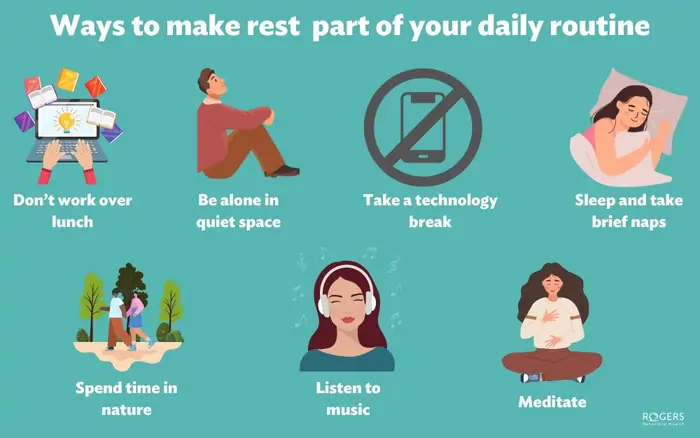Perfect Night Routine: Science-Backed Sleep Guide (2025)

Sleep deprivation affects more than one-third of adults in the U.S. The numbers paint a concerning picture – 14.5% of people can’t fall asleep, while 17.8% wake up throughout the night. A night routine that works isn’t just optional anymore – it’s essential.
The impact of good sleep might shock you. Men can add 5 years to their lives and women 2 years just by keeping consistent sleep habits. Regular sleep patterns matter more than how long you sleep when it comes to living longer.
Sleep plays a vital role in your body’s key functions. Your immune system, memory, and emotional balance all depend on quality rest. A proper bedtime routine doesn’t just help you sleep better – it enhances your overall quality of life.
Your sleep routine might need fine-tuning, or you may want to make it better. This complete, science-backed piece will help you create the perfect night routine. Take inspiration from prominent figures like Bryan Johnson, who scored a perfect 100% in sleep quality for eight straight months by sticking to consistent sleep habits.
📺 **Watch Now: Perfect Night Routine: Science-Backed Sleep Guide (2025)**
The Science Behind Effective Sleep Routines
Your brain craves routine more than you might think. Most people view sleep as simply “shutting down.” However, sleep scientists have found that there was a specific pattern your brain follows. This pattern helps with memory, removes toxins, and processes emotions. You can design a perfect night routine by understanding how your brain naturally works.
How Your Brain Responds to Consistent Patterns
A powerful internal timekeeper runs your body. This system is called the circadian rhythm—a 24-hour cycle that manages sleep, waking, and hormone production in the background [1]. This biological clock does more than make you feel tired. It controls your body temperature, immune system, metabolism, and brain function [1].
The suprachiasmatic nucleus (SCN), a tiny group of cells in your brain, works as your body’s master clock [2]. Light directly affects this structure. Blue light from phones and tablets can mess up your body’s natural melatonin production [1].
A regular sleep schedule supports your circadian rhythm better than anything else [1]. Your brain’s master clock learns to expect sleep and wake times when you stick to a schedule. This training helps your body prepare for rest and activity at the right times.
Research reveals that your brain performs vital maintenance work at night. During sleep, your brain:
Reorganizes and recharges itself [3]
Removes toxic waste byproducts accumulated throughout the day [3]
Processes and consolidates memories [3]
Regulates hormone production [3]
Your brain’s glymphatic system cleans out cellular waste 60% more effectively during sleep compared to waking hours [3]. This system removes toxins like beta-amyloid that can lead to brain disorders if they build up [4].
The Relationship Between Routines and Sleep Quality
Science proves that regular bedtime routines improve sleep quality and make it easier to fall asleep. A newer study, published by researchers showed that people who kept consistent sleep schedules had a 30% lower risk for mortality. They also had a 38% lower cardiometabolic mortality risk compared to irregular sleepers [5].
Studies of college students revealed that irregular bedtimes led to poor sleep quality and not enough rest [5]. The data showed that consistent routines helped people sleep better by reducing anxiety at bedtime [5].
Your nighttime routine sends strong signals to your brain that sleep time approaches. Regular calming activities before bed help your brain recognize when to start sleep processes. Scientists believe our brains might be wired to respond to these routines as a survival trait [4].
Sleep experts have found that bedtime routines work in several ways:
They lower cortisol (stress hormone) levels that can prevent sleep [2]
They create predictable signals that help set your body clock [1]
They reduce activity levels that might hide tiredness [6]
They minimize bedtime worry, which helps maintain sleep schedules [5]
A 30-60 minute wind-down routine can improve both sleep quality and quantity. The perfect night routine isn’t just random activities. It’s a carefully planned sequence that aligns with your brain’s natural processes to aid the transition from being awake to restful sleep.
Sleep scientists suggest keeping your routine between 30-60 minutes [7]. This gives your brain enough time to wind down without lasting so long that you become anxious about falling asleep.
Authoritative Resources:
Sleep Foundation: sleepfoundation.org/circadian-rhythm
National Institute of Neurological Disorders and Stroke: ninds.nih.gov/health-information/public-education/brain-basics/brain-basics-understanding-sleep
Cleveland Clinic: my.clevelandclinic.org/health/articles/circadian-rhythm
Related post: How To Get Better Sleep?
Assessing Your Current Sleep Situation
You need to learn about your unique sleep needs before creating the perfect night routine. Your sleep requirements differ based on genetics, environment, and lifestyle factors, just as no two people have similar fingerprints.
Identifying Your Sleep Chronotype
Your body’s natural preference to sleep and wake is your sleep chronotype. Your genes hardwire this biological tendency that affects everything from hormone levels to metabolic function [8].
Sleep researchers have identified four main chronotypes:
Lions (Early Birds): About 15% of the population are lions who naturally wake around 5am and feel most productive in the morning [9].
Bears: Bears make up about 40% of people who follow the sun’s schedule and work best between 11am and 6pm [9].
Wolves (Night Owls): These night owls represent 30% of people who naturally stay up until midnight or later and wake around 9am [9].
Dolphins: Light sleepers make up the remaining 15%. They often have insomnia and feel better with morning exercise that reduces anxiety [9].
Your chronotype helps you find your ideal bedtime. Scientists call it “social jetlag” when your body’s internal clock fights against your social schedule [10].
Common Sleep Disruptors to Eliminate
Your night routine improves when you know what keeps you awake. Scientists have discovered more than 80 different sleep disorders, and insomnia tops the list [11].
Several factors disrupt sleep quality beyond medical conditions:
External Disruptors:
Lighting: Bright lights stop melatonin production [3]
Environmental factors: Noise, uncomfortable temperature, unfamiliar surroundings [3]
Technology: Screen’s blue light disrupts natural sleep signals [3]
Internal Disruptors:
Physical discomfort: Chronic pain, headaches, or other physical conditions [11] [3]
Stress and anxiety: Psychological factors that trigger hyperarousal responses [3]
Medications: Certain antidepressants, blood pressure medications, and over-the-counter cold medicines [11]
Irregular sleep schedules, shift work, too much caffeine or alcohol, and aging also make sleep difficult [11] [11]. About 50% of adults over 65 experience some type of sleep disorder [11].
Using Sleep Tracking to Establish Baselines
Your current patterns need understanding before you can improve your sleep routine. Sleep tracking gives you a full picture of your sleep duration, quality, and cycles.
Modern sleep trackers monitor:
Total sleep time
Sleep stages (light, deep, REM)
Sleep disruptions and awakenings
Heart rate and respiration during sleep [12]
Consumer sleep-tracking devices work as well as or better than clinical actigraphy that doctors use [13]. These devices excel at detecting sleep periods but might overestimate total sleep time and struggle with specific sleep stages [13].
A meaningful baseline needs:
Sleep tracking for at least 1-2 weeks to spot patterns [4]
Recording both weeknight and weekend sleep habits to find inconsistencies [4]
Notes about lifestyle factors that might affect sleep (exercise, caffeine, stress levels) [12]
This baseline data shows if your night routine changes work. Research shows that tracking itself often creates better sleep habits by increasing awareness and accountability [4].
The most accurate results come from using both a sleep diary and technology. This combination captures objective measurements and your personal experience of sleep quality [14].
Authoritative Resources:
National Sleep Foundation: sleepfoundation.org/sleep-hygiene
Harvard Division of Sleep Medicine: sleep.hms.harvard.edu
American Academy of Sleep Medicine: aasm.org
Building Your Core Bedtime Routine
A well-laid-out perfect night routine can turn chaotic evenings into peaceful sleep transitions. Your bedtime routine should go beyond brushing teeth and changing into pajamas. It needs to be a sequence that tells your brain to wind down and get ready for restorative rest.
Essential Elements Every Routine Needs
Quality sleep needs several components that research supports:
Consistent schedule: Your brain’s sleep-wake rhythm works better when you sleep and wake at the same time daily—even on weekends [15].
Hygiene practices: Personal care activities like brushing teeth and washing face signal your body that sleep time approaches.
Relaxation techniques: Reading, gentle stretching, or calming music help reduce your body’s stress response [16].
Temperature management: Your bedroom temperature should be cool (around 65-68°F) to support your body’s natural core temperature drop during sleep [16].
Technology boundaries: Blue light from screens can suppress melatonin production, so avoid them 30-60 minutes before bed [16].
Research shows that consistent bedtime routines help you sleep earlier, fall asleep faster, sleep longer, and wake up less during the night [5]. People who managed to keep regular routines experienced these sleep quality benefits years later [5].
Customizing for Your Sleep Type
Your chronotype from the previous section is a vital factor in tailoring your routine. Each type needs different timing and activities:
Early Birds (Lions) do best with bedtimes between 9-10 PM. These people should prepare for morning (laying out clothes or preparing breakfast) as part of their evening routine [17].
Night Owls (Wolves) should work with their natural late-night tendency when possible. A gradual 15-minute routine adjustment helps minimize “social jetlag” if early wake-ups are needed [18].
Middle-of-the-road (Bears) sleep best with routines that match the solar cycle, heading to bed around 10-11 PM [19].
Light Sleepers (Dolphins) need anxiety-reducing activities before bed. Journaling worries or making tomorrow’s to-do list prevents racing thoughts [19].
Setting Realistic Timeframes
A good bedtime routine takes 30-60 minutes [20]. This gives you enough time to wind down without making it hard to maintain.
Your ideal bedtime calculation should:
Start with your wake-up time
Subtract 7-8 hours for sleep
Subtract 30-60 minutes for your routine
This gives you your routine start time [21]
Someone who needs to wake at 6:00 AM should sleep by 11:00 PM and start their routine at 10:00-10:30 PM [21].
Note that new routines need time. Small, manageable changes work better than complete evening overhauls [15]. Be patient—habits can take weeks or months to become automatic [15].
Recommended images:
Visual timeline of a 30-minute bedtime routine
Person engaging in relaxing bedtime activities
Bedroom environment optimized for sleep
Different routine activities for each chronotype
Before/after sleep improvement data from consistent routines
Authoritative Resources:
Sleep Foundation: sleepfoundation.org/sleep-hygiene/bedtime-routine-for-adults
National Heart, Lung, and Blood Institute: nhlbi.nih.gov/health/sleep
American Academy of Sleep Medicine: aasm.org
Nighttime Nutrition Strategies
Your food and drink choices in the hours before bedtime can make a huge difference in how well you sleep. Good nutrition helps you drift off faster and sleep better, while poor choices might leave you restless all night.
Foods That Help or Hinder Sleep
Diet and sleep quality share a deeper connection than most people think. Nature has packed several foods with compounds that help you sleep better:
Tryptophan-rich foods: Turkey, fish, and dairy products contain this amino acid that helps produce serotonin and melatonin—key hormones that regulate sleep [1].
Melatonin sources: Tart cherries help improve sleep quality and reduce insomnia symptoms [2]. Walnuts, almonds and pistachios also contain melatonin that supports better sleep [2].
Magnesium-rich options: Pumpkin seeds give you 37% of your daily magnesium needs, which activates GABA (a neurotransmitter that calms the nervous system) [22].
Kiwi fruit: Research shows eating two kiwis an hour before bedtime helps people fall asleep faster, sleep longer, and get better quality rest [1].
Some foods can mess with your sleep and you should skip them near bedtime:
Caffeine from coffee, tea, chocolate, and some ice creams acts as a stimulant that makes reaching deeper sleep stages harder [23]. Spicy foods boost body temperature at a time it should naturally drop for sleep [23]. Foods high in sugar cause blood sugar spikes and crashes that might wake you up at night [23].
Alcohol might make you drowsy at first but ends up disrupting sleep later by reducing REM sleep and deep sleep [23]. Fatty foods like cheeseburgers and fried items need more time to digest and often cause indigestion or acid reflux [23].
Timing Your Last Meal and Snacks
The clock matters as much as what’s on your plate. Scientists suggest eating your last full meal 2-4 hours before bed [24]. This gives your body enough time to digest and prevents stomach issues that could wake you up.
Your body handles food differently throughout the day. Morning hours work best for processing calories, while nighttime makes you more insulin resistant [7]. Late-night calories tend to become fat while you sleep instead of fueling your daily activities [7].
A small, nutrient-rich snack 30-60 minutes before bed can help if hunger strikes. Good choices include:
A banana with a tablespoon of peanut butter
Greek yogurt (contains GABA, which helps calm the body)
A small serving of complex carbs like oatmeal (contains melatonin)
Tart cherry juice
These light snacks (around 150 calories) satisfy hunger without causing digestive problems [25].
Hydration Balance for Uninterrupted Sleep
Getting your water balance right plays a big part in sleep quality. Not enough water can throw off your sleep-wake cycle [6] and cause dry mouth, headaches, and muscle cramps that make sleeping tough [6].
In spite of that, too much fluid before bed leads to bathroom trips that break up your sleep [26]. Here’s how to stay hydrated without disrupting rest:
Spread water intake throughout your day
Cut back on fluids 2-3 hours before bed
Take tiny sips if needed right before sleep
Caffeine and alcohol make you pee more and can leave you dehydrated. Stop drinking caffeine at least eight hours before bed and alcohol three hours before [6].
Your bedroom’s temperature affects how much water your body loses during sleep. A cool room (65-68°F) prevents excess sweating that might dehydrate you at night [6].
Smart evening nutrition and hydration choices create a solid foundation that supports peaceful, unbroken sleep.
Authoritative Resources:
Sleep Foundation: sleepfoundation.org/nutrition
Cleveland Clinic: health.clevelandclinic.org/foods-that-help-you-sleep
Harvard Sleep Medicine: sleep.hms.harvard.edu/education-training/public-education/sleep-and-health-education-program
Technology and Sleep: Finding Balance
Screen-emitted blue light might sabotage your sleep efforts. Technology can still play a positive role at the time you follow your perfect night routine mindfully.
Digital Tools That Actually Improve Sleep
Technology has earned a reputation as a sleep disruptor. However, certain digital tools can actually boost sleep quality:
Digital Cognitive Behavioral Therapy (CBT-I) applications are a great way to get evidence-based insomnia treatment. These tools become especially valuable when access to traditional therapy is limited [27].
Sleep tracking devices monitor sleep patterns and help you learn about your sleep quality and duration [10].
Relaxation apps like Headspace guide you through meditation exercises to reduce pre-sleep anxiety [9].
Smart devices that control bedroom temperature (around 67°F) maintain optimal sleep environments throughout the night [10].
Related post: Does Blue Light Damage Skin?
Creating a Healthy Tech Boundary
Electronic devices suppress melatonin production and disrupt circadian rhythms before bed [8]. You can counterbalance this effect with these steps:
Set an alarm to power down devices 2-3 hours before bedtime [28].
Use night mode features or install blue light filtering apps on devices you need [29].
Try amber-tinted glasses if screens are necessary in the evening [29].
Keep your devices charging outside the bedroom to avoid temptation [30].
Studies show that all but one of these Americans reach for electronic devices shortly before bedtime [28]. Removing technology from the bedroom improves sleep onset and quality significantly [31].
[Image suggestion: Infographic showing bedroom setup with devices charging outside the room]
Alternatives to Screen-Based Evening Activities
These sleep-friendly activities can replace your scrolling habit:
Creative pursuits like knitting or drawing can lead to a meditative flow state [11].
Reading physical books under warm lighting helps you avoid blue light exposure while your mind relaxes [11].
Light stretching or gentle yoga releases physical tension from your day [11].
Skincare routines can become mindful rituals that signal bedtime to your body [11].
[Image suggestion: Person engaged in a relaxing screen-free evening activity like reading]
Authoritative Resources:
Sleep Foundation: sleepfoundation.org
American Academy of Sleep Medicine: aasm.org
Harvard Health: health.harvard.edu
Evening Self-Care Rituals
A calm final hour before bedtime can substantially improve your sleep quality. Evening self-care rituals prepare your body for rest and tell your brain it’s time to slow down.
Stress-Reduction Techniques
Stress makes sleep difficult by triggering your body’s “fight or flight” response that lifts heart rate and stress hormones. Research shows that all but one of these adults experience chronic insomnia [3]. These evidence-based relaxation methods can help you create better sleep habits:
Diaphragmatic breathing: This belly-focused breathing technique uses the large muscle at your lungs’ base to reduce stress and help you breathe better [3].
Progressive muscle relaxation: Your body relaxes naturally as you systematically tense and release different muscle groups [3].
Meditation: Just 10 minutes of mindfulness meditation before bed helps adults sleep better [32].
Skincare as Mindfulness Practice
A nighttime skincare routine signals sleep time and offers more than just skin benefits. We practiced these rituals to promote relaxation:
Stay present during your cleansing routine instead of rushing through it [33].
Take time to speak kindly to yourself as you massage your face [34].
Think of skincare as your skin’s nightly reset ritual [12].
Your skin repairs itself most actively at night, which makes this care extra beneficial [13].
Related post: How to Build Your Skincare Routine
Body Temperature Management for Better Sleep
Your body needs to cool down by about 1°C to sleep well [4]. You can employ this biological fact:
A warm bath or shower 1-2 hours before bed helps your core temperature drop naturally [33].
Keep your bedroom between 66-70°F (19-21°C) [35].
Use appropriate bedding to create skin “microclimates” of 31-35°C [36].
The warm bath method works well – research analyzing 13 human trials found that passive warming for just ten minutes, 1-2 hours before bed, helps people fall asleep 36% faster [37].
Authoritative Resources:
Sleep Foundation: sleepfoundation.org
Mayo Clinic: mayoclinic.org
National Sleep Foundation: sleep.org
Conclusion
Science shows us how quality sleep shapes our physical health, mental clarity, and emotional well-being. Research proves that people who stick to regular sleep schedules live longer and substantially reduce their mortality risks.
Your perfect night routine needs to be tailored to you. A good sleep foundation starts with knowing your unique chronotype. You should manage your evening meals, set boundaries for technology use, and practice mindful self-care rituals.
Note that lasting changes take time. You can start with small tweaks to your evening habits. Pick a consistent bedtime or stop using devices 30 minutes before sleep. Sleep tracking tools help monitor your progress as your body adapts to the new routine.
[Image: Graph showing sleep quality improvement over time with consistent routine]
Sleep science keeps evolving, but the basics stay the same. Our bodies need routine, respond to environmental signals, and need proper time to wind down. Your investment in a science-backed sleep routine leads to boosted productivity, better health, and a richer life.
Authoritative Resources:
National Sleep Foundation (sleepfoundation.org)
American Academy of Sleep Medicine (aasm.org)
Harvard Division of Sleep Medicine (sleep.hms.harvard.edu)
FAQs
What are some effective strategies for improving sleep quality in 2025?
To improve sleep quality, try taking a magnesium supplement before bed, keeping your bedroom cool (65-68°F) and dark, using a weighted blanket, and considering a vibrating mattress massager. Additionally, maintain a consistent sleep schedule and create a relaxing bedtime routine.
Can you explain the 10-3-2-1-0 sleep rule?
The 10-3-2-1-0 rule is a guideline for better sleep: Stop caffeine 10 hours before bed, avoid food and alcohol 3 hours before, cease work 2 hours before, turn off screens 1 hour before, and don’t hit the snooze button (0 times) in the morning. This helps prepare your body and mind for quality sleep.
How can I create an ideal bedtime routine?
To create the perfect bedtime routine, set a consistent bedtime, avoid electronics before sleep, have a light snack or herbal tea, take a warm bath, listen to calming music, practice relaxation techniques like stretching or meditation, and read a book. These activities signal to your body that it’s time to wind down.
What are the essential components of a good night routine?
A perfect night routine typically includes the “5 B’s”: Bath (or shower), Bottle (or light snack), Brush (teeth), Book (reading), and Bed. This sequence helps create a calming environment and prepares both body and mind for sleep. Consistency is key in establishing these habits.
How does technology impact sleep, and what alternatives are there?
Technology, especially blue light from screens, can disrupt sleep patterns. Instead of using devices before bed, try alternative activities like reading physical books, light stretching, gentle yoga, or engaging in creative pursuits like drawing or knitting. These screen-free activities can help relax your mind and prepare you for better sleep.
References
[1] – https://www.healthline.com/nutrition/9-foods-to-help-you-sleep
[2] – https://www.sleepfoundation.org/nutrition/food-and-drink-promote-good-nights-sleep
[3] – https://www.sleepfoundation.org/sleep-hygiene/relaxation-exercises-to-help-fall-asleep
[4] – https://www.sleepstation.org.uk/articles/sleep-tips/wind-down-routine/
[5] – https://www.sleepfoundation.org/children-and-sleep/bedtime-routine
[6] – https://www.sleepfoundation.org/nutrition/hydration-and-sleep
[7] – https://health.clevelandclinic.org/is-eating-before-bed-bad-for-you
[8] – https://www.health.harvard.edu/staying-healthy/blue-light-has-a-dark-side
[9] – https://www.sleephealthsolutionsohio.com/blog/sleep-gadgets-apps/
[10] – https://www.thensf.org/technology-and-sleep/
[11] – https://magazine.avocadogreenmattress.com/screen-free-activities/
[12] – https://theordinary.com/en-us/blog/nighttime-skincare-routine.html
[13] – https://www.amway.com/en_US/discover/skincare/sleep-for-skin-nighttime-skin-care-routine
[14] – https://www.ncbi.nlm.nih.gov/books/NBK592970/
[15] – https://www.sleepfoundation.org/sleep-habits
[16] – https://www.sleep.com/sleep-health/bedtime-routine
[17] – https://www.sleepfoundation.org/how-sleep-works/chronotypes
[18] – https://rightasrain.uwmedicine.org/body/rest/sleep-chronotypes
[19] – https://perelelhealth.com/blogs/news/how-to-find-the-perfect-sleep-routine-according-to-your-chronotype?srsltid=AfmBOooxoeYmanywF6APkzTeJsg2k2R4n3pb8-GpxQq3QnVQUokkE9b1
[20] – https://www.sleepfoundation.org/sleep-hygiene/bedtime-routine-for-adults
[21] – https://andreadekker.com/organized-days-start-organized-nights/
[22] – https://www.aarp.org/health/healthy-living/superfoods-for-sleep/
[23] – https://www.sleephealthsolutionsohio.com/blog/foods-avoid-before-sleep/
[24] – https://www.sleepfoundation.org/nutrition/is-it-bad-to-eat-before-bed
[25] – https://www.sleepfoundation.org/nutrition/healthy-bedtime-snacks
[26] – https://www.olara.com.au/blogs/lifestyle/the-connection-between-hydration-and-sleep-finding-the-right-balance?srsltid=AfmBOor7RRIkGM1Iq7yZBIzElV_-YuLMgd0sjouaKaXgkh6o9QFVaONN
[27] – https://aasm.org/digital-cognitive-behavioral-therapy-for-insomnia-platforms-and-characteristics/
[28] – https://www.webmd.com/sleep-disorders/sleep-blue-light
[29] – https://www.sleepfoundation.org/bedroom-environment/blue-light
[30] – https://bettersleep.org/blog/technology-and-sleep-setting-boundaries-for-a-more-restful-night/
[31] – https://www.sleepfoundation.org/bedroom-environment/technology-in-the-bedroom
[32] – https://www.sleepfoundation.org/sleep-hygiene/how-to-relieve-stress-for-bedtime
[33] – https://www.healthline.com/health/nighttime-routine
[34] – https://www.purabotanicals.com/blogs/pura-botanicals-green-beauty-blog/beauty-sleep-how-your-evening-skincare-rituals-can-transform-your-skin
[35] – https://sleepopolis.com/education/thermoregulation-sleep/
[36] – https://www.frontiersin.org/journals/neuroscience/articles/10.3389/fnins.2019.00336/full
[37] – https://pmc.ncbi.nlm.nih.gov/articles/PMC7323637/









